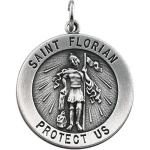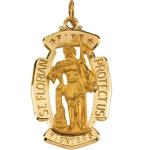Florian lived during the third century, during the time of the Roman emperors Diocletian and Maximian. He was a high-ranking officer in the Roman army who was stationed in Noricum, which is now part of Austria. Florian was also a closet Christian.
This was problematic because the Roman Empire had not yet started to embrace the Christian faith. In fact, the Romans were taking steps at that time to wipe out Christianity.
When ordered to behave in a way contrary to his religious beliefs (one version of the story is that he was ordered to make a sacrifice to a pagan god; another is that he was ordered to participate in the execution of Christians), he revealed the true nature of his faith to the authorities. One can only admire this man's courage and strength of character, since he certainly would have known what the consequences of his actions would have been.
The consequences were swift and without mercy. Florian was whipped, beaten, and set on fire by his former colleagues. Finally, he was killed by drowning in the River Enns, a millstone tied around his neck.
The body was recovered and buried. At a later time, his remains were exhumed and moved to the Augustinian Abbey of St. Florian, which is near Linz.
St. Florian is depicted in many different ways. In some cases, he is shown as a warrior with a lance, as a man with a sword, or a man wearing armour. Other images used are of Florian being beaten or of his dead body lying on a millstone. At other times, he is shown pouring water onto a burning church.
St. Florian's feast day is observed on May 4. He is the patron saint of Poland, Linz, and Austria. St. Florian is also the patron saint of firefighters, a group of people also admired for their courage under very difficult circumstances.





